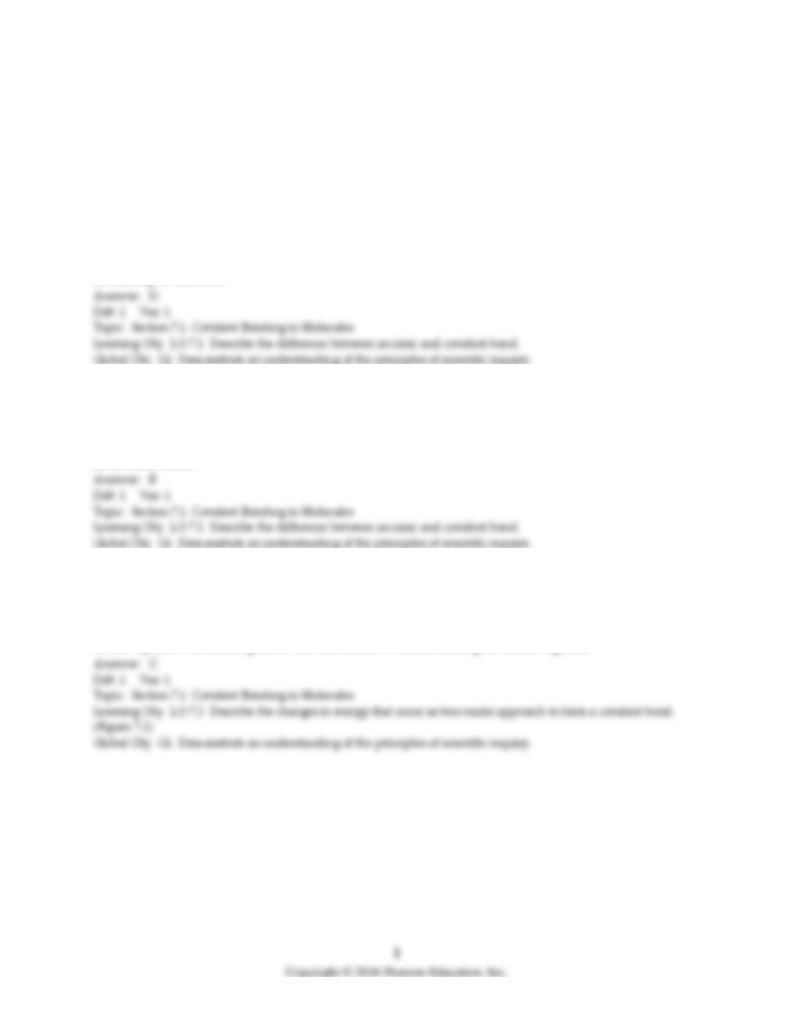
Chemistry, 7e (McMurry/Fay)
Chapter 7 Covalent Bonding and Electron-Dot Structures
7.1 Multiple-Choice Questions
1) Covalent bonding is a
A) gain of electrons.
B) loss of electrons.
C) transfer of electrons.
D) sharing of electrons.
2) Which electrostatic forces hold atoms together in a molecule?
A) electron-electron forces
B) electron-nucleus forces
C) nucleus-nucleus forces
D) all three forces
3) At the equilibrium bond length
A) the attractive forces holding the atoms together are less than the repulsive forces.
B) the potential energy is a maximum.
C) the potential energy is a minimum.
D) the repulsive forces are greater than the attractive forces holding the atoms together.
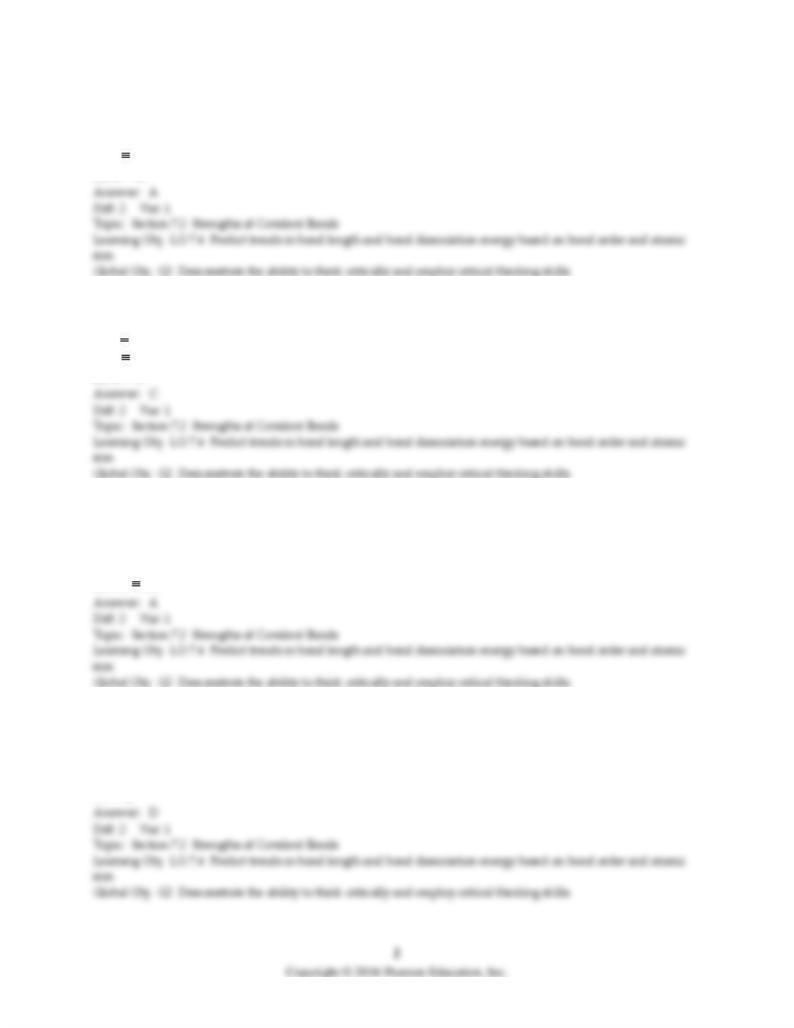
4) Which is the longest bond?
A) N—N
B) N=N
C) N N
D) N—H
5) Which bond should have the highest bond dissociation energy?
A) N—N
B) N N
C) N N
D) N—H
6) Which molecule contains the most easily broken carbon-carbon bond?
A) H3C—CH3
B) H2C=CH2
C) F2C=CF2
D) HC CH
7) Which molecule has the weakest bonds?
A) CF4
B) CCl4
C) CBr4
D) CI4
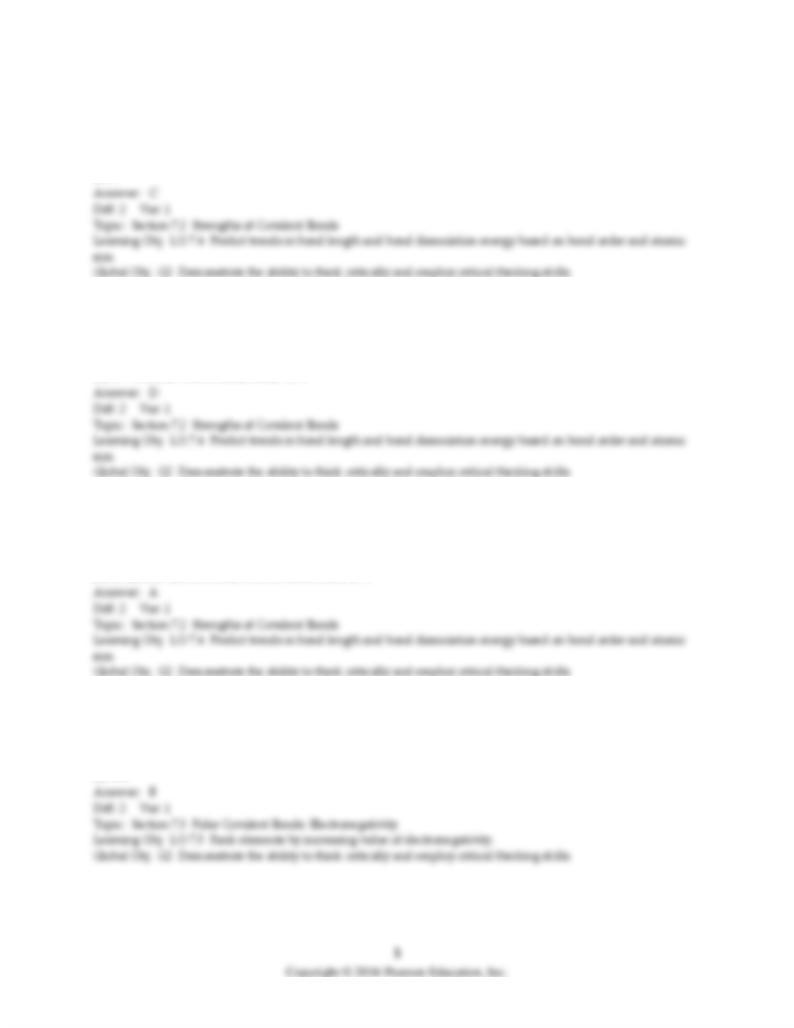
8) What is the bond order of the O—O bond in O2?
A) 0
B) 1
C) 2
D) 3
9) Which of the following bonds is expected to be stronger?
A) C—C bond with a bond order of 0
B) C—C bond with a bond order of 1
C) C—C bond with a bond order of 2
D) C—C bond with a bond order of 3
10) What bond distance is expected to be longest?
A) A carbon-carbon bond with a bond order of 0
B) A carbon-carbon bond with a bond order of 1
C) A carbon-carbon bond with a bond order of 2
D) A carbon-carbon bond with a bond order of 3
11) Of the following elements, which has the highest electronegativity?
A) Si
B) N
C) Ga
D) Cd
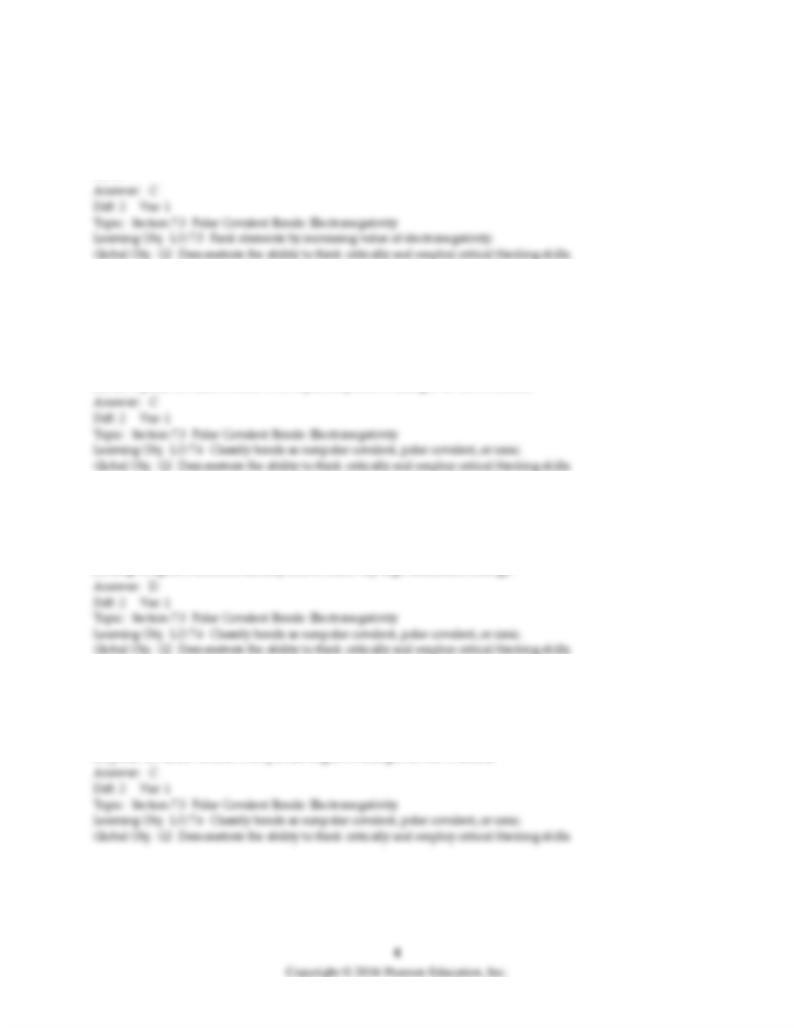
12) Of the following elements, which has the lowest electronegativity?
A) Sn
B) As
C) S
D) Tl
13) The electronegativity is 2.1 for H and 3.0 for N. Based on these electronegativities, NH4+ would be
expected to
A) be ionic and contain H- ions.
B) be ionic and contain H+ ions.
C) have polar covalent bonds with a partial negative charges on the H atoms.
D) have polar covalent bonds with a partial positive charges on the H atoms.
14) A reactive element with a relatively high electronegativity would be expected to have a relatively
A) small negative electron affinity and a relatively low ionization energy.
B) small negative electron affinity and a relatively high ionization energy.
C) large negative electron affinity and a relatively low ionization energy.
D) large negative electron affinity and a relatively high ionization energy.
15) The compound CCl4 contains
A) ionic bonds.
B) nonpolar covalent bonds.
C) polar covalent bonds, with partial negative charges on the Cl atoms.
D) polar covalent bonds, with partial negative charges on the C atoms.
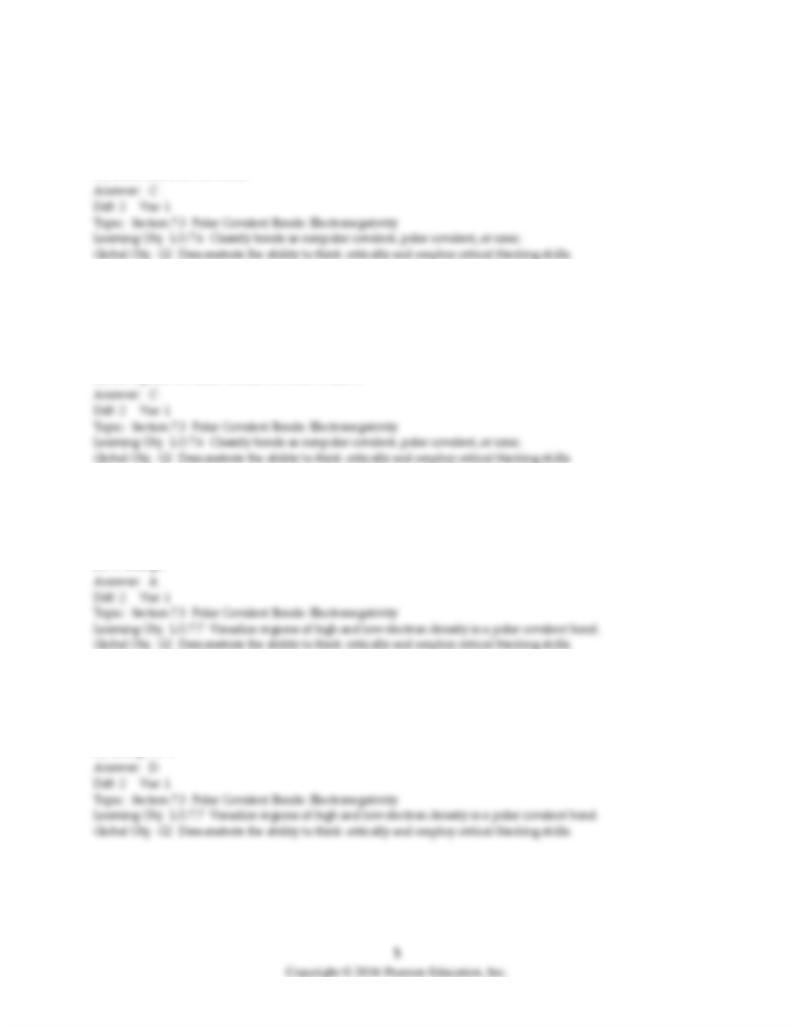
16) The greater the electronegativity difference between two bonded atoms, the
A) greater the bond order.
B) greater the covalent character of the bond.
C) greater the ionic character of the bond.
D) more unstable the bond.
17) The electronegativity for both sulfur and carbon is 2.5. Therefore the compound CS2 would be
expected to
A) be ionic with C as the anion.
B) be ionic with C as the cation.
C) have nonpolar covalent bonds between C and S.
D) have polar covalent bonds between C and S.
18) The phosphorus atom in PCl5 would be expected to have a
A) partial positive (δ+) charge.
B) partial negative (δ-) charge.
C) 3+ charge.
D) 3- charge.
19) A nitrogen atom in N2 should have a
A) charge of 1-.
B) partial charge δ-.
C) partial charge δ+.
D) charge of 0.
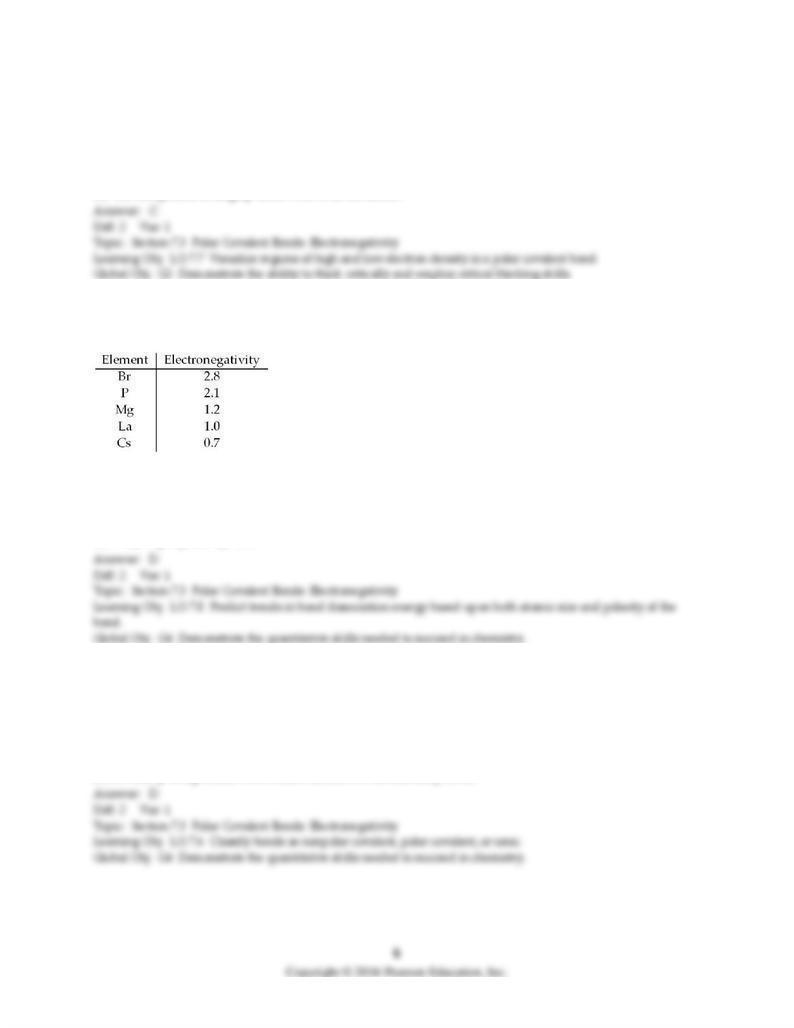
20) Element A has an electronegativity of 0.8 and element B has an electronegativity of 3.0. Which
statement best describes the bonding in A3B?
A) The AB bond is largely covalent with a δ- on A.
B) The AB bond is largely covalent with a δ+ on A.
C) The compound is largely ionic with A as the cation.
D) The compound is largely ionic with A as the anion.
21) Based on the indicated electronegativities, arrange the following in order of increasing ionic character:
CsBr, LaBr3, PBr3, MgBr2.
A) CsBr, LaBr3, MgBr2, PBr3
B) CsBr, MgBr2, PBr3, LaBr3
C) PBr3, LaBr3, MgBr2, CsBr
D) PBr3, MgBr2, LaBr3, CsBr
22) The electronegativities for the elements vary from 0.7 for cesium to 4.0 for fluorine. The
electronegativity for iodine is 2.5. Based entirely on the general guidelines for electronegativities and
bond character,
A) binary compounds with iodine should all be polar covalent with a δ- on I.
B) binary compounds with iodine should all be polar covalent with a δ+ on I.
C) compounds with iodine may be ionic, polar covalent, or nonpolar covalent.
D) no binary compounds with iodine should be substantially ionic.
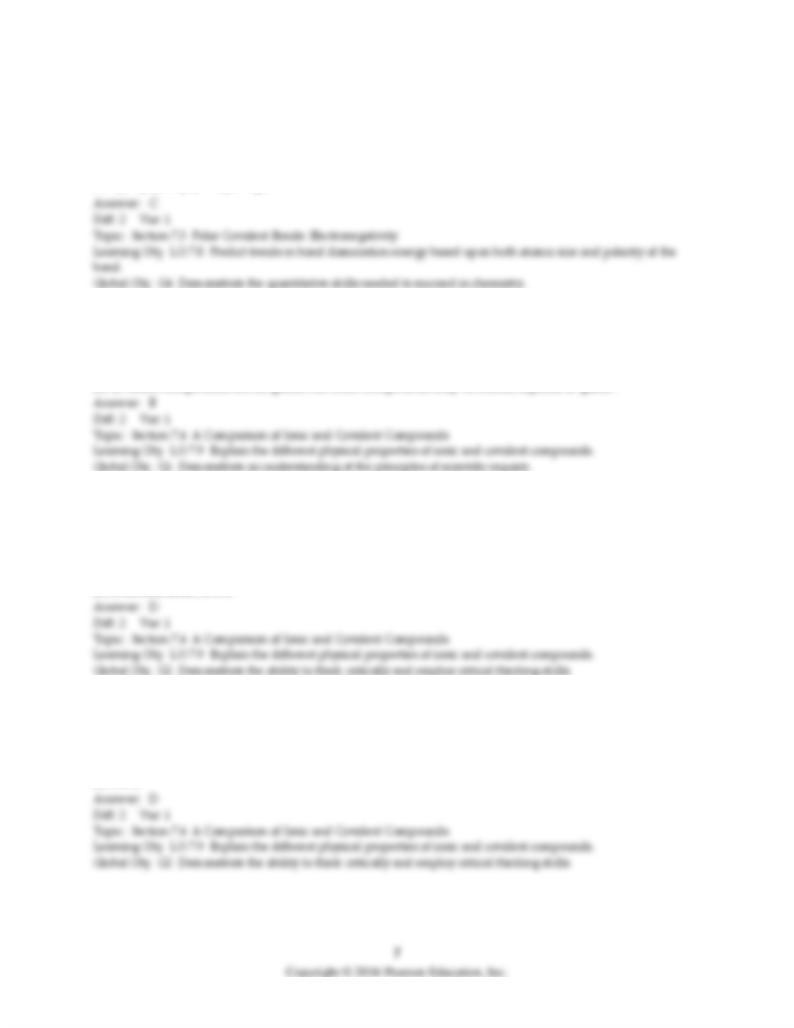
23) Arrange the following in order of increasing ionic character: Al2S3, MgS, Na2S, P4S3, S8.
A) MgS, Na2S, Al2S3, P4S3, S8
B) Na2S, MgS, Al2S3, P4S3, S8
C) S8, P4S3, Al2S3, MgS, Na2S
D) S8, P4S3, Al2S3, Na2S, MgS
24) In general, at room temperature
A) ionic compounds are all solids and covalent compounds are all gases.
B) ionic compounds are all solids, but covalent compounds may be solids, liquids, or gases.
C) ionic compounds are all solids, and covalent compounds are liquids or gases.
D) covalent compounds are all gases, but ionic compounds may be solids, liquids, or gases.
25) When melting S8, ________ forces must be overcome and S8 is expected to have a ________ melting
point than MgS.
A) covalent bonding, higher
B) covalent bonding, lower
C) intermolecular, higher
D) intermolecular, lower
26) Which of the following molecules is expected to have the highest melting point?
A) H2
B) Cl2
C) CCl4
D) NaCl
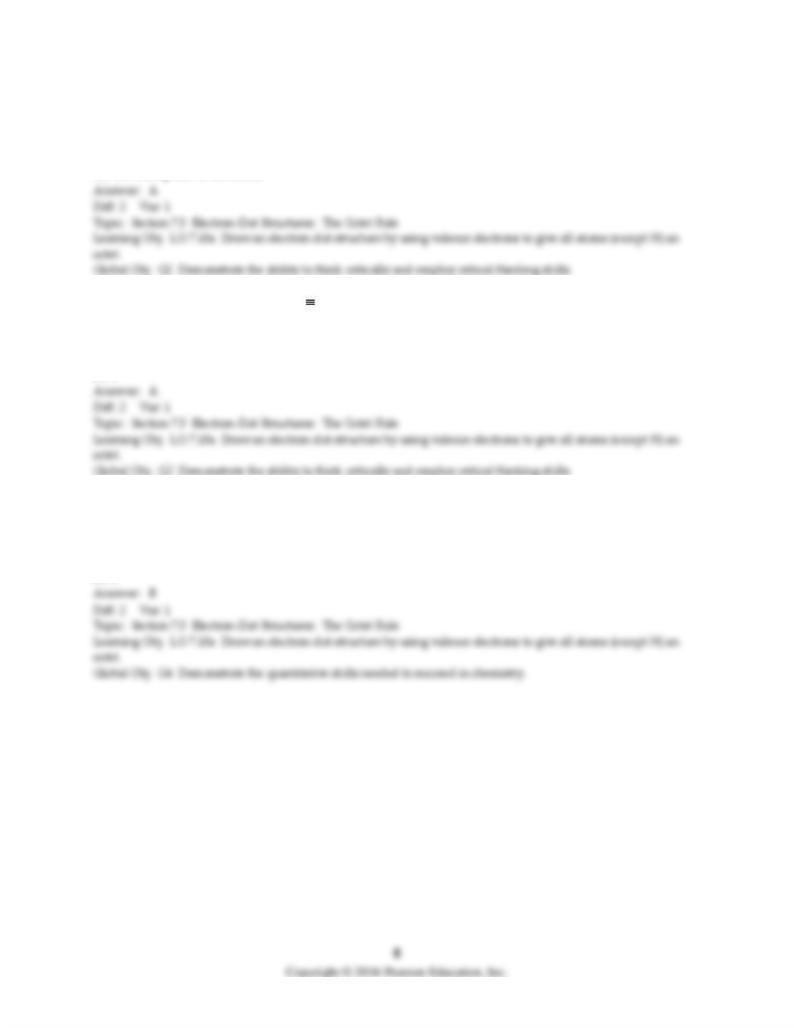
27) A::A represents
A) a double bond.
B) a quadruple bond.
C) one lone pair of electrons.
D) two lone pairs of electrons.
28) The nitrogen-nitrogen bond in :N N: has a bond order of
A) 3
B) 1
C) 2
D) 6
29) How many of the σ bonds in H2SO4 are coordinate covalent bonds?
A) 0
B) 2
C) 4
D) 6
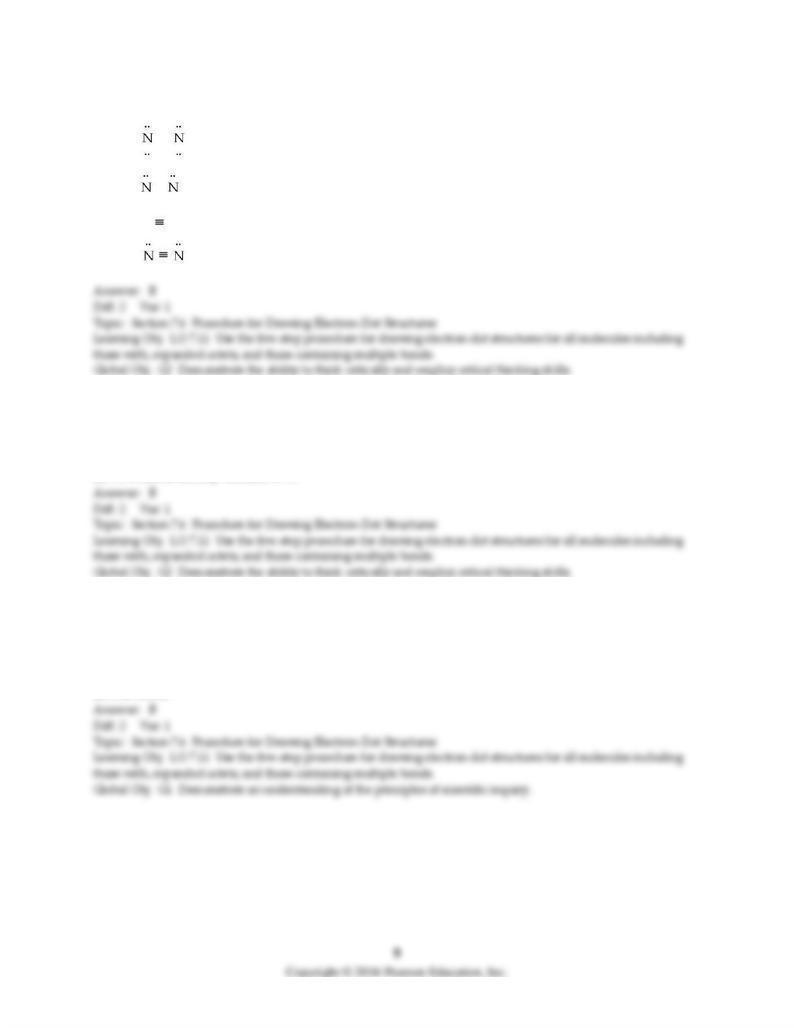
30) Which is the most acceptable electron dot structure for N2H2?
A) H — — — H
B) H —=— H
C) H — N N — H
D) H — — H
31) In the most acceptable electron-dot structure for carbonyl fluoride, COF2 the central atom is
A) C, which is singly-bonded to O.
B) C, which is doubly-bonded to O.
C) O, which is singly-bonded to C
D) O, which is doubly-bonded to C.
32) Elements that can accommodate more than eight electrons in their valence shell occur only in periodic
table row
A) 2 or lower.
B) 3 or lower.
C) 4 or lower.
D) 5 or lower.
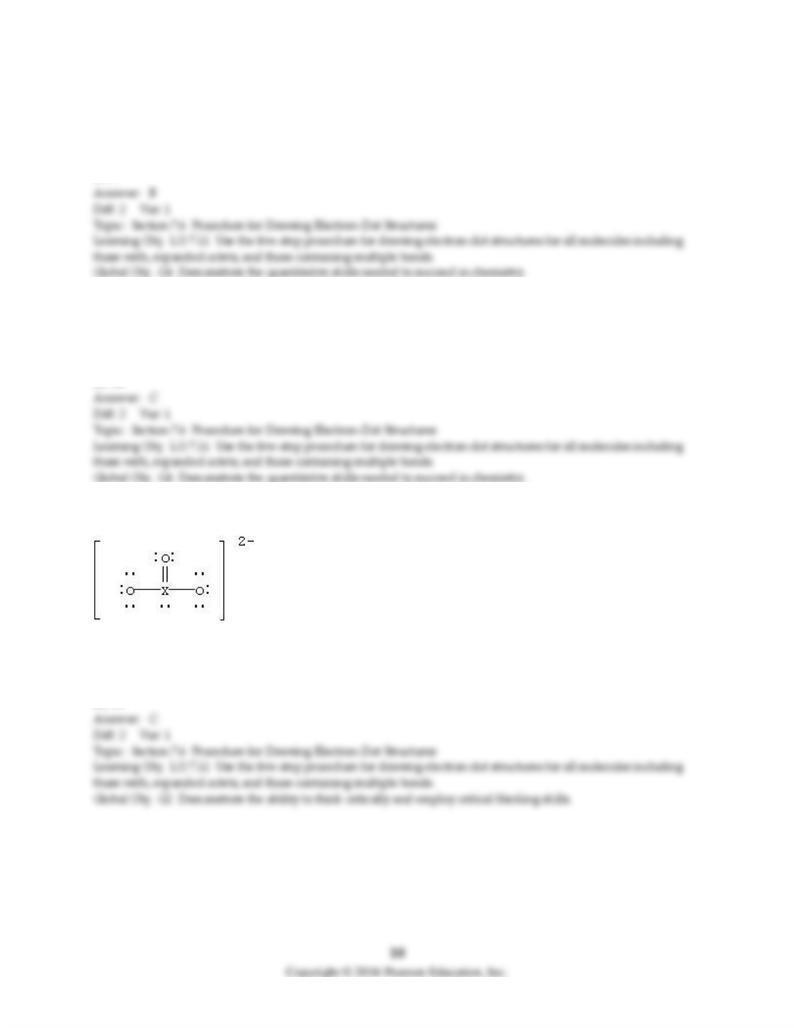
33) How many lone pairs of electrons are on the I atom in IF5?
A) 0
B) 1
C) 2
D) 3
34) How many electrons are in the valence shell of I in IF4-?
A) 8
B) 10
C) 12
D) 14
35) Identify the fourth-row element X that forms the ion.
A) Ge
B) As
C) Se
D) Kr

36) Consider a molecule with the following connections:
When a valid electron dot structure is written, how many double bonds will the molecule contain?
A) 0
B) 1
C) 2
D) 4
37) How many lone pairs are on the Br atom in BrI2-?
A) 0
B) 1
C) 2
D) 3
38) In the electron dot structure of HCN, the bond order of CN is
A) 0
B) 1
C) 2
D) 3
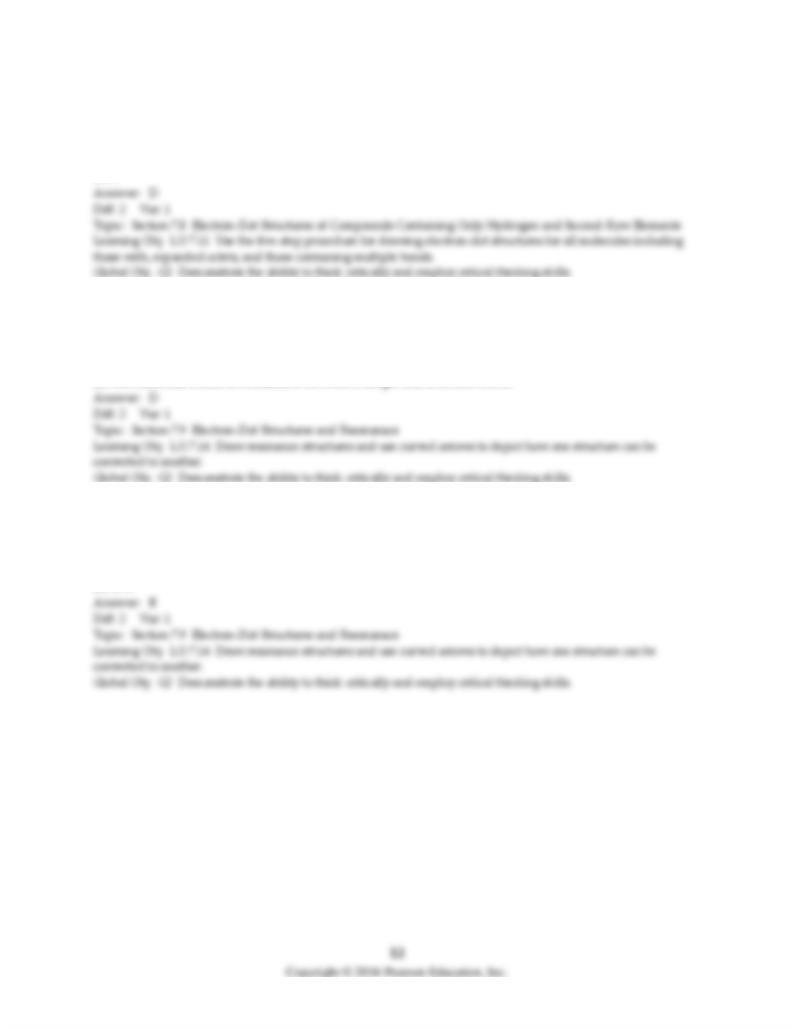
39) How many lone pairs in the correct electron dot structure of O3?
A) 2
B) 3
C) 4
D) 6
40) NO2- is be expected to have
A) two single bonds.
B) one single and one double bond.
C) two double bonds.
D) two identical bonds intermediate between a single and a double bond.
41) How many resonance structures are required in the electron-dot structure of CO32-?
A) two
B) three
C) four
D) five
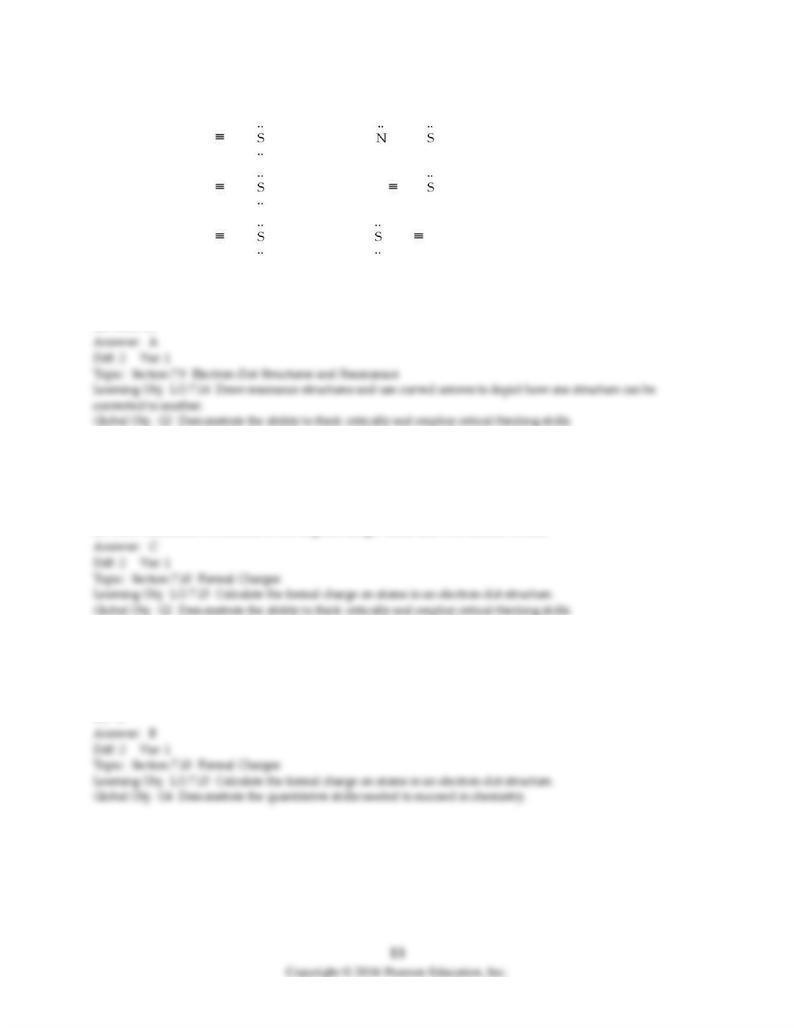
42) Which of the following are allowed resonance forms of NCS-?
I [: N C —:] – and [: = C = :] –
II [: N C —:] – and [: N C = :] –
III [: N C — :] – and [: — C N :] –
A) only I
B) only II
C) only III
D) I and III
43) Based on formal charge considerations, the electron-dot structure of CO32- ion has
A) two resonance structures involving two single bonds and one double bond.
B) two resonance structures involving one single bond and two double bonds.
C) three resonance structures involving two single bonds and one double bond.
D) three resonance structures involving one single bond and two double bonds.
44) In the best Lewis structure for CO2, what is the formal charge on the C atom?
A) -1
B) 0
C) +1
D) +2
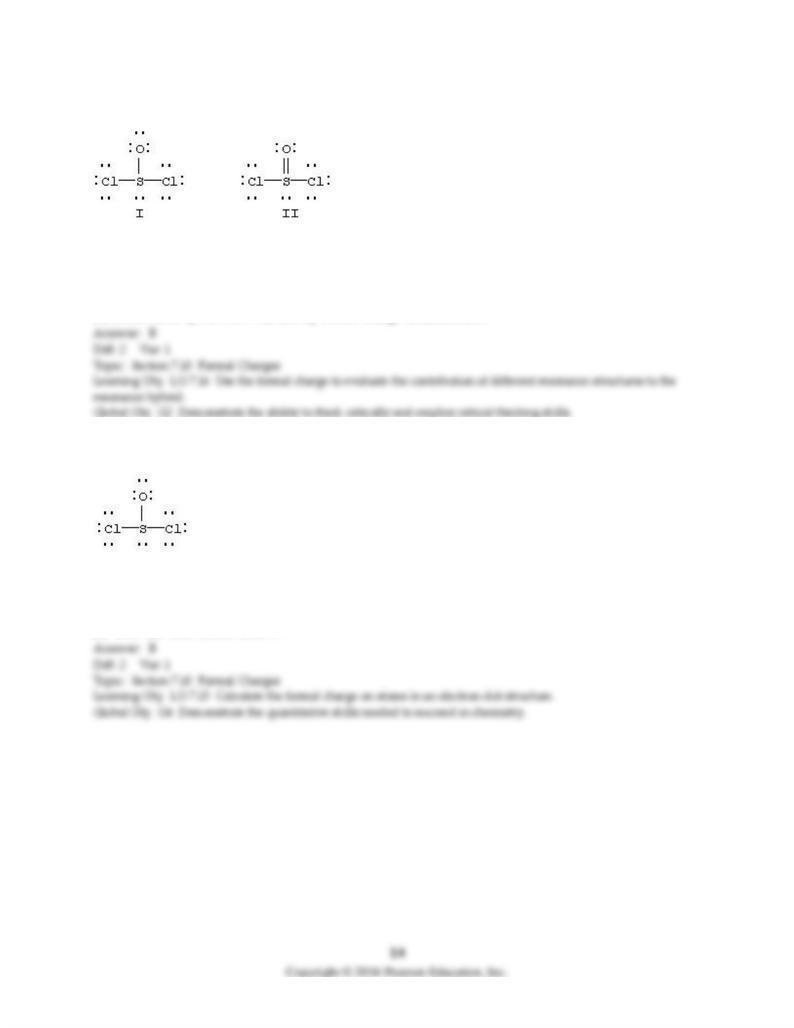
45) Two resonance forms for SOCl2 are given below.
Which is favored by the octet rule and which by formal charge considerations?
A) I is favored by the octet rule and by formal charge considerations.
B) I is favored by the octet rule and II by formal charge considerations.
C) II is favored by the octet rule and I by formal charge considerations.
D) II is favored by the octet rule and by formal charge considerations.
46) Assign formal charges to each atom in the resonance form for SOCl2 given below.
A) 0 for Cl, 0 for S, and 0 for O
B) 0 for Cl, +1 for S, and -1 for O
C) -1 for Cl, +4 for S, and -2 for O
D) -1 for Cl, -2 for S, and -2 for O

47) Assign formal charges to each atom in the resonance form for SOCl2 given below.
A) 0 for Cl, 0 for S, and 0 for O
B) 0 for Cl, +1 for S, and -1 for O
C) -1 for Cl, +4 for S, and -2 for O
D) -1 for Cl, -2 for S, and -2 for O
48) Which electron dot structure for OCN- has a formal charge of -1 on the most electronegative atom?
A) [: = C = :] –
B) [: N C —:] –
C) [: — C O :] –
D) [: — O C :] –
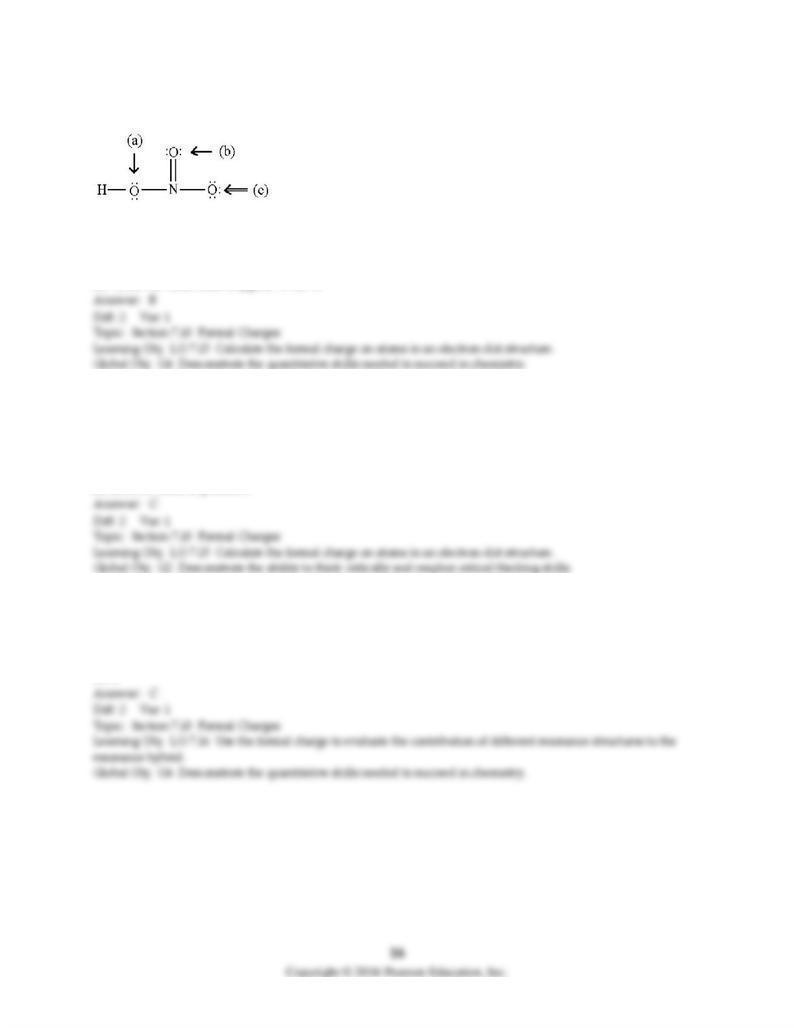
49) Assign formal charges to all atoms in the following resonance form for HNO3.
A) 0 for all atoms
B) +1 for N, -1 for oxygen (c), 0 for all other atoms
C) +1 for N and H, -1 for oxygen (a) and oxygen (c), 0 for oxygen (b)
D) +1 for H, -2 for each oxygen, +5 for N
50) How many double and single bonds are in the resonance form for SO2 in which the formal charges on
each atom are zero?
A) two single bonds and no double bonds
B) one single bond and one double bond
C) no single bonds and two double bonds
D) Each of these is possible.
51) Based on formal charges, what is the S—O bond order in SO42-?
A) 1
B) 1.3
C) 1.5
D) 2
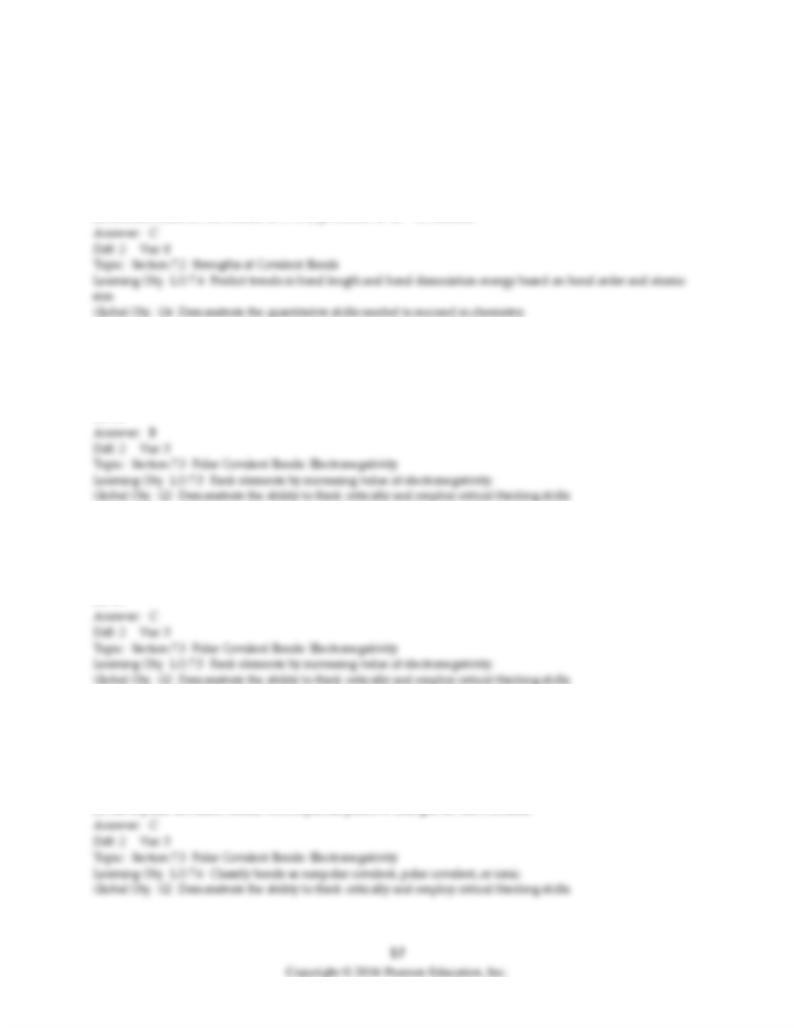
7.2 Algorithmic Questions
1) The Cl—Cl bond energy is 199 kJ/mol. Therefore the formation of a single bond between atoms
A) should require the absorption of 199 kJ per mole of Cl—Cl formed.
B) should require the absorption of 398 kJ per mole of Cl—Cl formed.
C) should result in the release of 199 kJ per mole of Cl—Cl formed.
D) should result in the release of 398 kJ per mole of Cl—Cl formed.
2) Of the following elements, which has the highest electronegativity?
A) As
B) Se
C) Y
D) Sb
3) Of the following elements, which has the lowest electronegativity?
A) Ba
B) I
C) Ra
D) At
4) The electronegativity is 2.1 for H and 1.9 for Sb. Based on these electronegativities SbH3 would be
expected to
A) be ionic and contain H- ions.
B) be ionic and contain H+ ions.
C) have polar covalent bonds with a partial negative charges on the H atoms.
D) have polar covalent bonds with a partial positive charges on the H atoms.
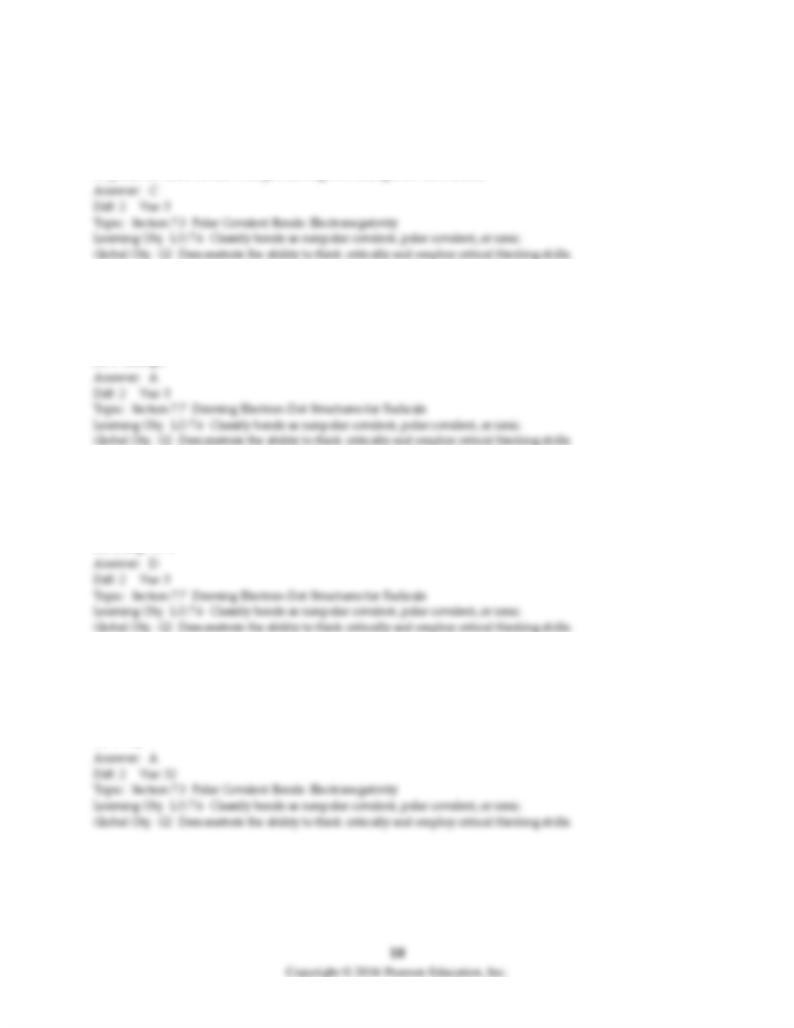
5) The compound ICl contains
A) ionic bonds.
B) nonpolar covalent bonds.
C) polar covalent bonds with partial negative charges on the Cl atoms.
D) polar covalent bonds with partial negative charges on the I atoms.
6) The phosphorus atom in PCl5 would be expected to have a
A) partial positive (δ+) charge.
B) partial negative (δ-) charge.
C) 3+ charge.
D) 3- charge.
7) The chlorine atom in Cl2 would be expected to have a
A) charge of 1-.
B) partial charge δ-.
C) partial charge δ+.
D) charge of 0.
8) Which molecule contains the most polar bonds?
A) CF4
B) TeO2
C) NO-
D) CCl4
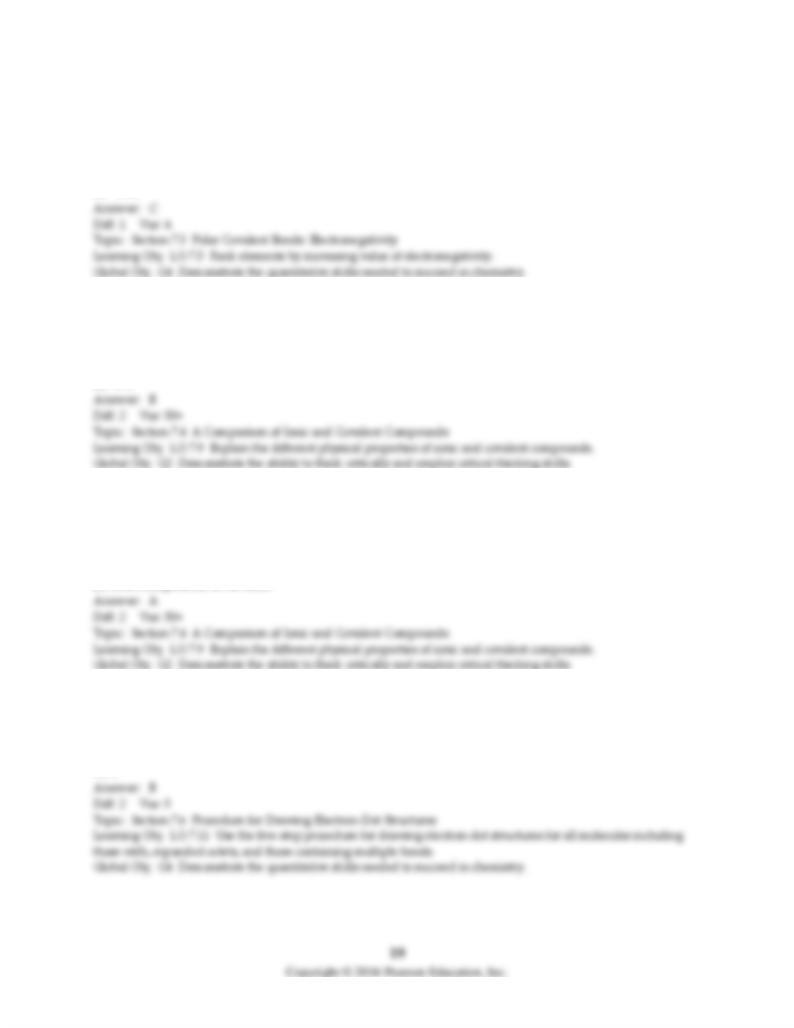
9) The electronegativity value of C is 2.5 while the electronegativity value of F is 3.98. What is the
expected electronegativity value for the C-F bond?
A) 0
B) 6.48
C) 1.48
D) -1.48
10) Which compound is most likely to exist as a gas or liquid at room temperature?
A) Al4C3
B) CBr4
C) CaBr2
D) WC
11) Compound A is a solid with a melting point of 85°C, and compound B is a gas at 75°C and one
atmosphere pressure. Based on these data, one would expect
A) both compounds to be covalent.
B) compound A to be ionic and compound B to be covalent.
C) compound A to be covalent and compound B to be ionic.
D) both compounds to be ionic.
12) How many lone pairs of electrons are on the P atom in PF3?
A) 0
B) 1
C) 2
D) 3

13) How many lone pairs of electrons are on the N atom in NBr3?
A) 0
B) 1
C) 2
D) 3
14) Which molecule contains a triple bond?
A) O2
B) O3
C) HCCH
D) Br2SO
15) Which element can expand its valence shell to accommodate more than eight electrons?
A) C
B) F
C) Xe
D) He
16) Which element can accommodate more than eight electrons in its valence shell?
A) N
B) O
C) Ga
D) Ne
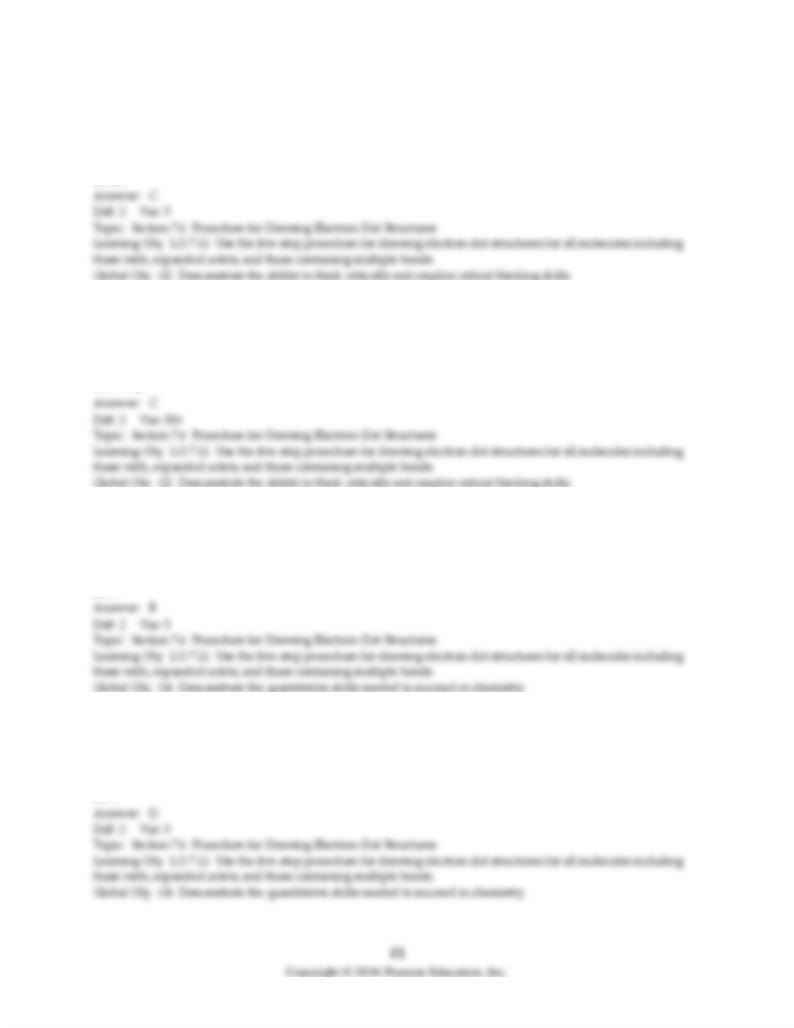
17) Which of the following contains an atom that does not obey the octet rule?
A) NaCl
B) SiO2
C) BrF3
D) BrF
18) Which of the following contains an atom that does not obey the octet rule?
A) LiBr
B) CO2
C) PCl3
D) CCl4
19) How many lone pairs of electrons are on the Xe atom in XeF6?
A) 0
B) 1
C) 2
D) 3
20) How many lone pairs are on the central Br atom in Br3-?
A) 0
B) 1
C) 2
D) 3
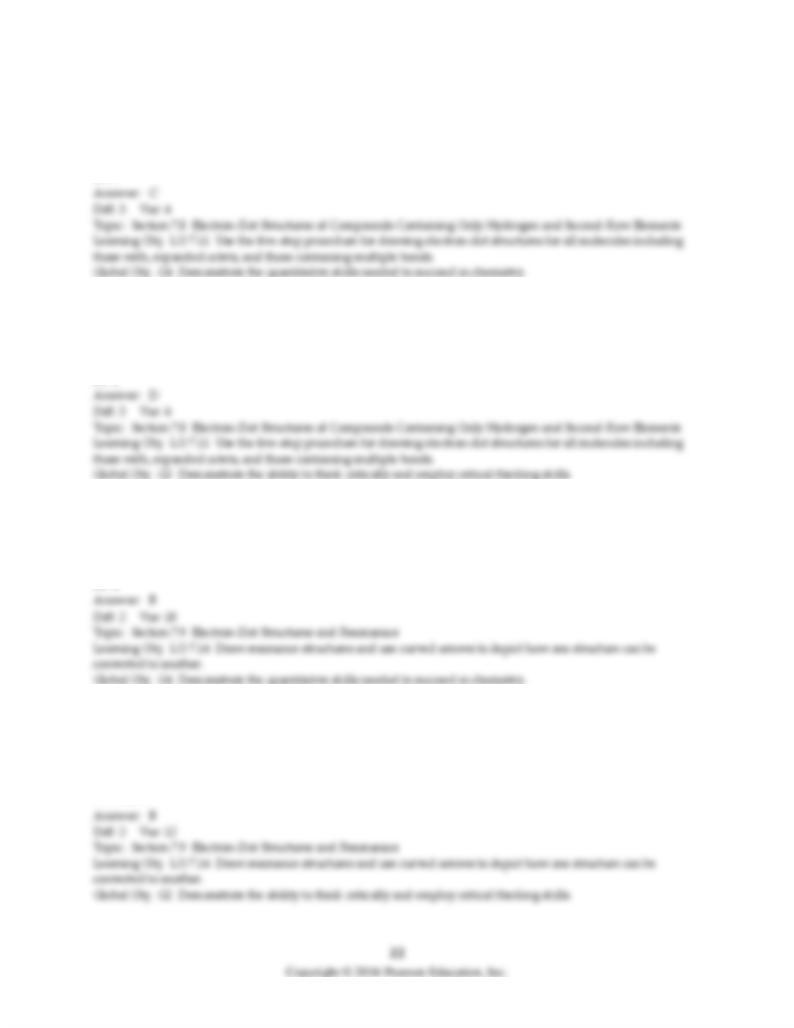
21) How many carbon-carbon bonds are present in C3H8?
A) 3
B) 1
C) 2
D) 0
22) How many lone pairs are there in the Lewis structure of O2?
A) 3
B) 1
C) 0
D) 4
23) What is the approximate carbon-oxygen bond order in CO32-?
A) 2
B) 4/3
C) 5/3
D) 4
24) Which is expected to have the strongest C—O bond?
A) CH3OH
B) Cl2CO
C) CF3CO2-
D) CO32-
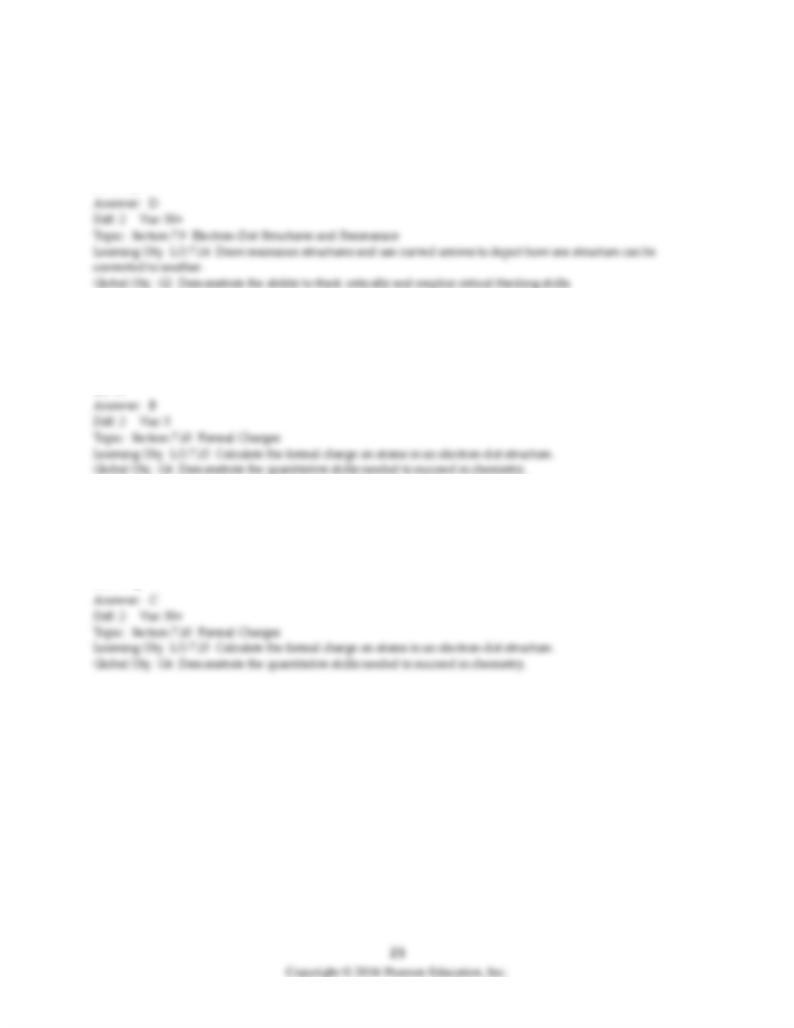
25) Which one of the following is expected to exhibit resonance?
A) NH4+
B) HCN
C) CS2
D) NO3-
26) In the best Lewis structure for CN -, what is the formal charge on the N atom?
A) -1
B) 0
C) +1
D) +2
27) A molecular compound that obeys the octet rule in which all atoms have a zero formal charge is
A) SrBr2.
B) BrF3.
C) NH3.
D) XeF4.
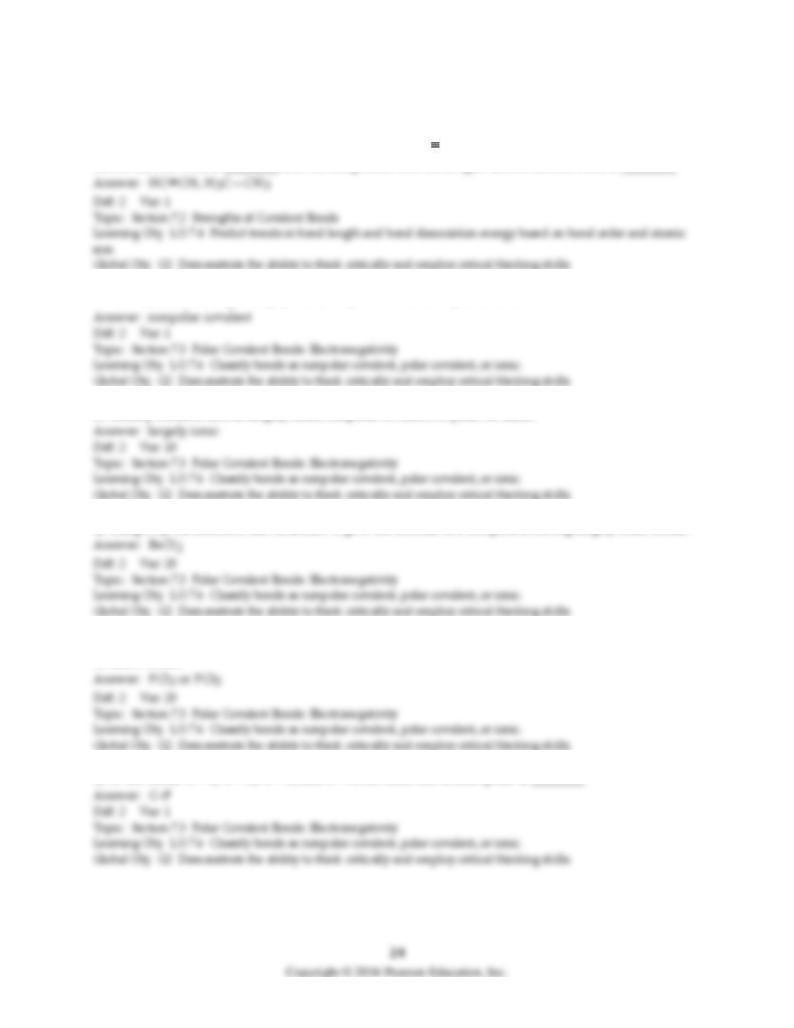
7.3 Short Answer Questions
1) Among the compounds H3C—CH3, H2C=CH2, and HC CH, the compound with the strongest
carbon-carbon bond is ________, and the compound with the longest carbon-carbon bond is ________.
2) Classify bonds in As4 as largely ionic, nonpolar covalent, or polar covalent.
3) Classify bonds in BeS as largely ionic, nonpolar covalent, or polar covalent.
4) Using only the elements Be, Cl, and/or P, give the formula of a compound having largely ionic bonds.
5) Using only the elements Mg, Cl, and/or P, give the formula of a compound having largely polar
covalent bonds.
6) Of the bonds C—C, C—N, C—O, and C—F, the bond that is most polar is ________.
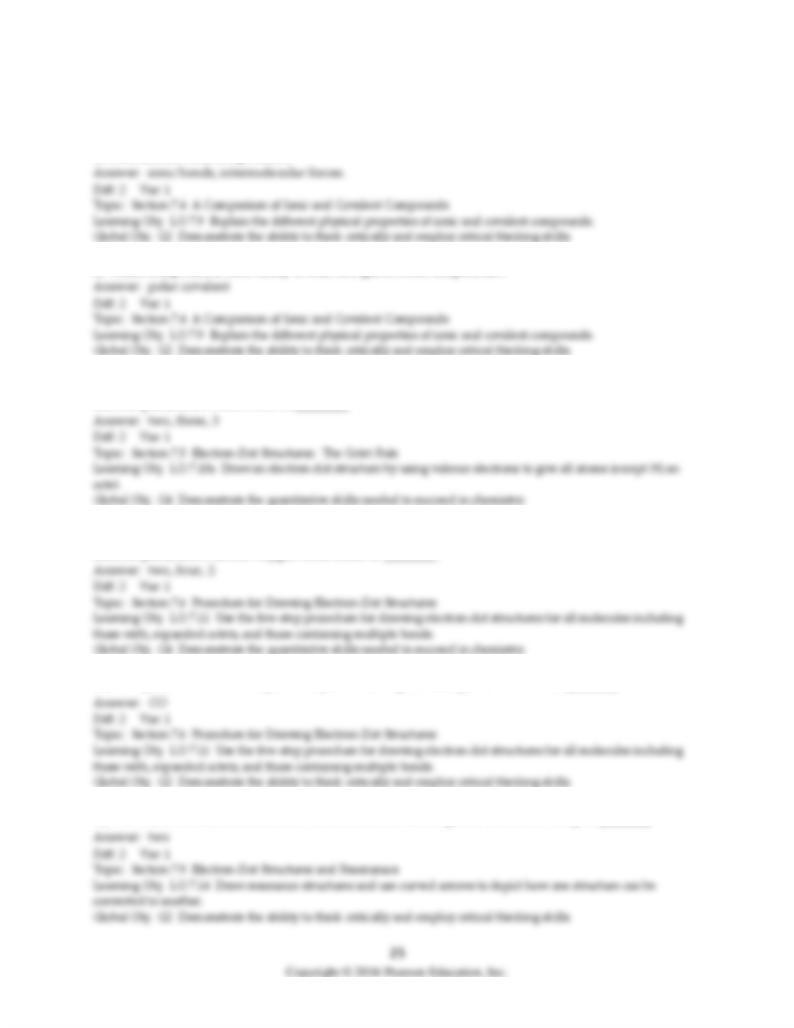
7) Ionic compounds consist of a single three-dimensional network of ions that are attracted to one another
by strong ________ and usually exist in the solid state at room temperature, whereas covalent compounds
consist of molecules that are attracted to one another by weak ________ and can exist in gaseous, liquid,
or solid state at room temperature.
8) Which compound is most likely to exist as a gas at room temperature?
9) The Lewis electron-dot structure of N2 has ________ nonbonding electrons pairs, ________ bonding
electron pairs, and a bond order of ________.
10) The Lewis electron-dot structure of H2CO has ________ nonbonding electron pairs, ________ bonding
electron pairs, and a carbon-oxygen bond order of ________.
11) Of H2CO and CO and CO2, the compound having the strongest C—O bond is ________.
12) The number of Lewis electron dot resonance structures required to describe NO2- is ________.
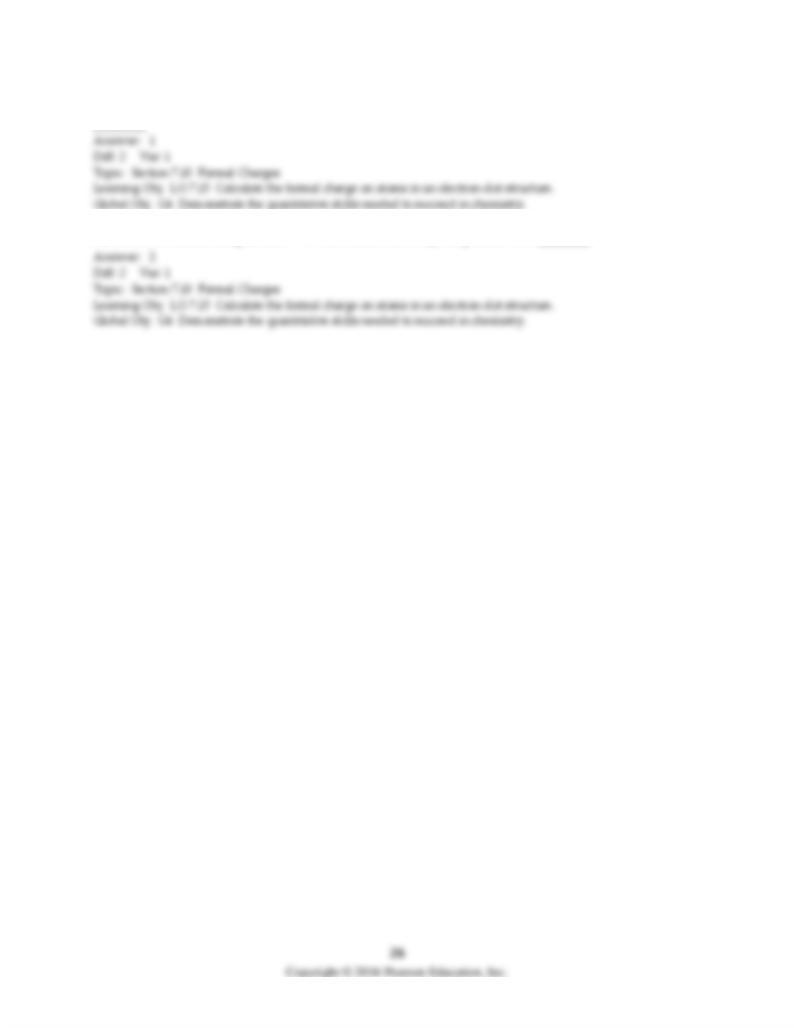
13) Based on formal charges, the best Lewis electron-dot structure of BF3 has a B—F bond order equal to
________.
14) Based on formal charges, the P—O bond order in POCl3 is expected to be ________.